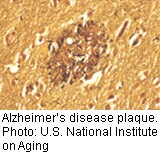Home > Weekly Newsletters > Seniors
September 1, 2008
Antipsychotic Drug Use Up in Elderly Despite Warnings

MONDAY, Aug. 25 (HealthDay News) -- Safety warnings slowed the use of antipsychotic drugs in seniors with dementia. But the overall use of the drugs in the elderly increased, a finding which suggests that warnings may not be sufficient to protect patients, Canadian researchers say.
Between late 2002 and June 2005, Health Canada issued three warnings that three new atypical antipsychotic drugs increased the risk of stroke and death in elderly patients with dementia.
The researchers analyzed prescription drug data in the province of Ontario and found that antipsychotic drug use among the elderly increased 20 percent from the month prior to the first warning in September 2002 to February 2007. About 70 percent of the seniors receiving antipsychotic drugs lived in nursing homes, and about 40 percent of them were 85 or older.
"This finding highlights the limited impact of warnings and suggests that more effective approaches are needed to protect vulnerable populations from potentially hazardous medications," wrote Dr. Geoffrey Anderson, of the University of Toronto, and colleagues.
The study was published in the Canadian Medical Association Journal.
Some health care warnings don't have much effect, because the warnings don't provide doctors with information about the safety and effectiveness of alternative treatments, Dr. Laurence Katz, of the University of Manitoba, wrote in an accompanying comment article.
More information
The Annals of Internal Medicine has more about antipsychotic drug use in seniors with dementia
.
Computer-Based Method IDs Alzheimer's Protein Structures

FRIDAY, Aug. 22 (HealthDay News) -- A new method of identifying protein structures related to Alzheimer's disease has been developed by researchers at the Massachusetts Institute of Technology.
The research team says its computer-based technique could help in the development of drugs that could prevent the formation of such structures.
Alzheimer's disease is characterized by two kinds of proteins (amyloid and tau) that accumulate in the brain. In a study published in the Aug. 22 issue of PLoS Computational Biology, the MIT team focused on tau.
Most proteins have similar structures, so "you can measure the lengths of individual molecules, and the average will be a pretty good description of any one," team leader Dr. Collin M. Stultz, an associate professor of biomedical engineering, explained in an MIT news release.
But tau molecules "are all over the place -- they're so diverse that it's difficult to get one measurement that describes all of the possible structures," Stultz said. This makes it a challenge to detect specific tau structures associated with Alzheimer's.
The MIT team developed a method called Energy-minima Mapping and Weighting (EMW) and "generated lots and lots of structures for both normal tau and a mutant form" associated with an increased risk for Alzheimer's disease.
Further analysis revealed that one structure was more common in the mutant form of tau and therefore likely to play a role in the development of Alzheimer's. That structure could become a target for new drug development, Stultz said.
The study looked at one mutant form of tau associated with Alzheimer's, but there are several others. Stultz said he hopes to use EMW to create "a list of all types of suspect conformations for known tau mutants. Then, from that list, we can design drugs for each."
More information
The U.S. National Institute on Aging has more about Alzheimer's disease.
Dietary Supplements May Pose Risk to Older Cancer Survivors
THURSDAY, Aug. 21 (HealthDay News) -- Older cancer survivors need to listen to warnings about the potential risks of dietary supplements, say Duke University Medical Center researchers and colleagues.
They noted that many older cancer patients who've survived five years or more take vitamins, minerals and other dietary supplements in an effort to remain disease-free. However, this supplement use may backfire.
"One of the most common behavioral changes cancer survivors make -- sometimes without a doctor's advice, often on their own -- is using dietary supplements in hopes of bolstering their health," researcher Denise Snyder, clinical trials manager at the Duke School of Nursing, said in a university news release. "Still, it's unclear whether supplements really help keep cancer survivors healthier or put them at further risk. They, like many other people today, use the Internet, and you can find a lot of false hope out there with supplements targeted at cancer survivors."
Snyder and colleagues at Pennsylvania State University and the University of Texas M.D. Anderson Cancer Center studied 753 cancer survivors, age 65 and older. About 75 percent of them were taking dietary supplements, including multivitamins (60 percent), calcium/vitamin D (37 percent), antioxidants (30 percent), and herbs, amino acids and glandular extracts.
"In our study, we see people taking supplements who have good diets and who are relatively healthy. While they may need a particular vitamin because they don't get enough of it, they may not need a multivitamin or supplement because of the increased risk of cancer recurrence or secondary cancer," Snyder said.
Before they start to take supplements, older cancer survivors should talk with their health care provider or a registered dietitian, she advised.
The study was published in the Journal of Cancer Survivorship.
More information
The American Cancer Society offers health advice for cancer survivors
.
3.4 Million Seniors Hit Medicare 'Doughnut Hole'
THURSDAY, Aug. 21 (HealthDay News) -- In 2007, about 3.4 million Americans enrolled in the Medicare Part D drug plan reached a gap in their prescription coverage known as the "doughnut hole," leading some of them to stop taking prescribed drugs, says a Kaiser Family Foundation study released Thursday.
The analysis of data found that 26 percent of Part D enrollees who filled any prescriptions in 2007 reached the coverage gap. This includes 22 percent who were stuck in the gap for the remainder of the year and 4 percent who eventually received catastrophic coverage.
When they applied this estimate to the all Part D enrollees, the study authors concluded that last year about 3.4 million beneficiaries (14 percent of all Part D enrollees) reached the coverage gap and faced paying full cost for their prescriptions.
Enrollees prescribed drugs for serious chronic conditions had a much higher risk of a gap in coverage under the Part D plan. For example, 64 percent of enrollees taking medications for Alzheimer's disease reached the coverage gap, along with 51 percent of those taking oral anti-diabetic medications and 45 percent of those taking antidepressants.
The data analysis didn't include beneficiaries who receive low-income subsidies, because they don't face a gap in coverage under their Medicare drug plan.
The study authors also found that some patients altered their use of prescription drugs when they reached the coverage gap and had to pay the full cost of their medications. The researchers looked at eight classes of drugs used to treat a variety of common conditions and found that 15 percent of Part D enrollees who reached the gap stopped their drug therapy, 5 percent switched to another medication in the same class, and 1 percent reduced the number of drugs they were taking in the class.
"The Medicare drug benefit has produced tangible relief for millions of people, despite the unusual coverage gap that was created to make the benefit fit within budget constraints," Kaiser CEO and President Drew Altman said in a news release. "But if a new president and Congress consider changes to the drug benefit, it will be important to keep in mind that the coverage gap has consequences for some patients with serious health conditions."
More information
The American Academy of Family Physicians has more about Medicare Part D
.

